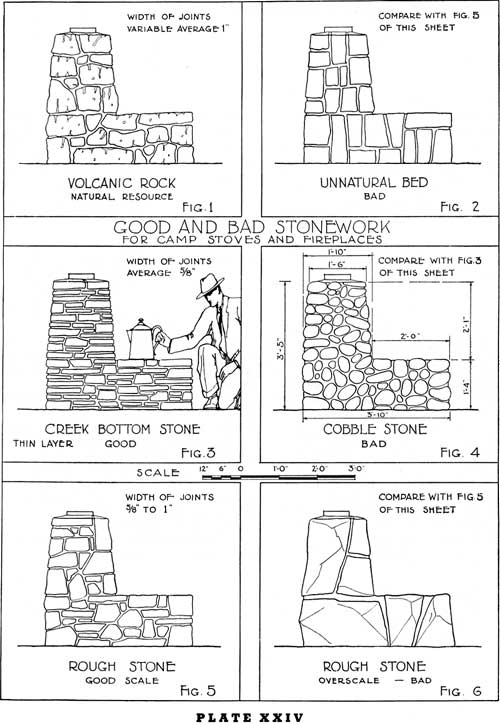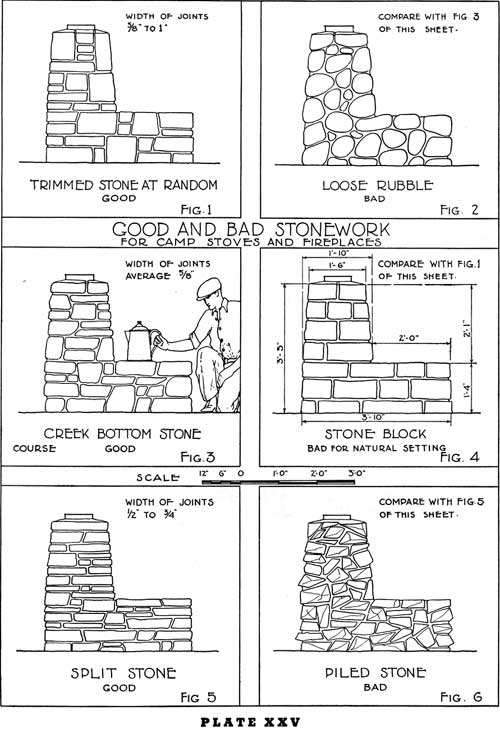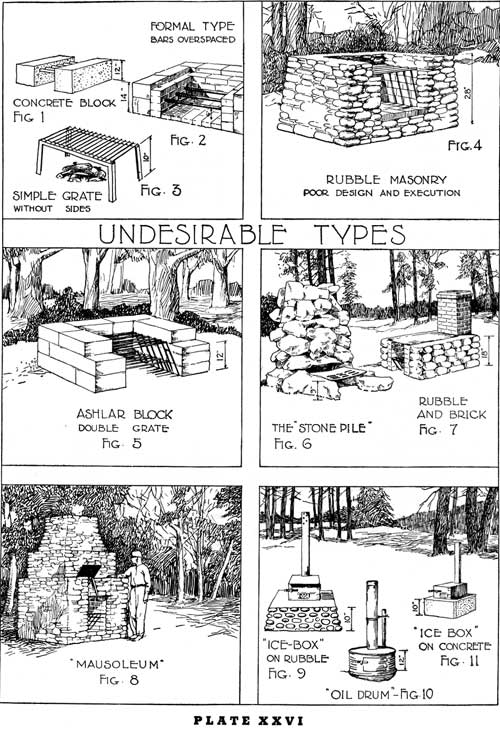|
CAMP STOVES AND FIREPLACES
|

|
FREQUENT MISTAKES
IN FIREPLACE AND CAMP STOVE DESIGN AND CONSTRUCTION
A. Structures too large and too conspicuous to be in harmony with surroundings.
B. Structures too complicated in design and construction.
C. Lack of proper setting, or necessary screening, as viewed from important points.
D. Lack of character in texture of stone work and unfortunate selection of stones.
E. Lack of consideration for correct details of construction in lining walls or firebox.
F. Use of common mortar for fire-clay brick lining and making joints in fire-clay brick construction too thick.
G. Excessive size of firebox.
H. Incorrect construction in attaching bars and top plates to masonry without making provision for expansion.
I. Spacing of bars in top grate too far apart.
J. Incorrect reenforcing and lack of proper attachment for top plate, in order to prevent warping.
K. Having top plate too thick and thus preventing efficient heating.
L. Existence of sharp corners in construction of stone masonry.
M. Making stone masonry walls so thick that there is inconvenience in using the top plate for cooking.
N. Lack of provision for adequate flat wall space on which to set cooking utensils.
O. Building chimneys with flues on fireplaces which do not have a solid top plate. In such instances the flue is useless.
P. Using too many movable parts and of not sufficient strength to prevent them from being easily bent or broken.
GOOD AND BAD STONEWORK
THE stonework in a great many of the existing fireplaces which have been observed by the author is not well done. The type of stonework which seems appropriate and inappropriate for camp stoves and fireplaces is illustrated on the accompanying plates (XXIV and XXV).
The mistakes which are frequently made in the texture of stonework in fireplaces are the following:
A. Using a type of stone which is not adapted for this kind of a unit, as shown in plate XXIV, figure 6, and in plate XXV, figure 6.
B. Laying the stonework on an unnatural bed which does not create a pleasing composition in the camp stove or fireplace design (pl. XXIV, fig. 2; pl. XXV, fig. 6).
C. Using a type of texture which is too formal for such a feature in naturalistic surroundings (pl. XXV, fig. 4).
D. Using cobblestones which are not carefully laid and produce a loose and unstable effect (pl. XXIV, fig. 4).
It is very essential that the stonework be constructed in a permanent way and that the texture of the stonework be appropriate to the naturalistic surroundings.
So far as is practical, the horizontal effect which is excellently illustrated in plate XXV, figures 3 and 5, and plate XXIV, figure 3, should be procured if possible.
No camp stove or fireplace should be constructed to present the formal effect of stone texture which is illustrated in plate XXV, figure 4. The use of broken stone with sharp angles and laid in such a manner that the surface texture is very uneven and the mortar joints deep, as shown in plate XXV, figure 6, should also be very definitely avoided. This same type of stone, if carefully selected and well laid, can produce an appropriate and desirable effect. When laid as shown in plate XXV, figure 6, it gives the effect of an uninteresting pile of stones with no character in texture.
The stone which is laid on an unnatural bed, as shown in plate XXIV, figure 2, and producing the vertical effect, increases the apparent height of the camp stove; while the stone laid on a natural bed and producing a horizontal effect, as shown in plate XXIV, figure 3, decreases the apparent height of the camp stove.
The camp stove which is constructed of oversized units of stone with rough surface, as shown in plate XXIV, figure 6, is to be discouraged.
In general, it is not a logical procedure to use in every instance the stone which is available in any specific locality without making an effort to find stone which is better adapted for camp stove construction.
The above discussion relates primarily to stoves and fireplaces that expose a surface of stonework sufficient to be designated as a "wall." In the case of the primitive and naturalistic fireplaces, both the size of the stones and the method of laying may be varied as shown in the various drawings.

|
|
PLATE XXIV. (click on image for a PDF version) |

|
|
PLATE XXV. (click on image for a PDF version) |
UNDESIRABLE TYPES
FIGURE 1
A fireplace unit, whether portable or stationary, with walls of concrete, is out of place in any natural surrounding. The concrete fails to weather sufficiently to produce any softening effect and it disintegrates under extreme changes of temperature (especially when doused with water).
FIGURE 2
The hard and formal cut stone or dimension stone should not be used in any natural setting. Such fireplaces (well designed) may have their proper place on some parts of private estates and home grounds; but not in the forest. An equally undesirable type of design is that which exposes the fire-clay brick across the front of the fireplace, as shown in figure 2. The use of large grate bars, spaced so far apart that the grill is not practical for cooking purposes, should be avoided.
FIGURE 3
As stated elsewhere in this discussion, the standard grate, without sides as shown in this sketch, is only practical and desirable on picnic areas which are intensively used, and where the fire hazard is negligible. There is a proper use for this grate, as shown in plate I, figures 4, 6B, and 6C, and in plates III and III—A.
FIGURE 4
An example of a "clumsy" fireplace, with an unusually large firebox and a type of cobblestone texture which makes this feature exceedingly undesirable.
FIGURE 5
The stonework in such fireplaces is very "cold" and unattractive. The firebox has no fire-clay brick lining. The use of the lower grate is not practical and the solid attachment of the grate or the bars to the stone masonry causes undue damage because of expansion from the heat.
FIGURE 6
This type is all chimney and no fireplace. It has all of the undesirable qualities which could possibly be introduced into a single unit. It is more of an ill-proportioned chimney than a fireplace.
FIGURE 7
An incongruous type of construction, with a brick chimney and stone masonry sides, where the stone texture is extremely unattractive because of the regular courses of small boulders, which create an unstable effect.
FIGURE 8
A monumental type of fireplace which would "roast an ox" as quickly as it would broil lamb chops. The top of the firebox (approximately 36 to 40 inches in height) is too high. The stonework is much too fine in texture and the entire massive effect is one which should be avoided.
FIGURES 9, 10, AND 11
The "ice box" and the "oil drum" types are to be avoided on every possible occasion because of their very inappropriate design.

|
|
PLATE XXVI. (click on image for a PDF version) |
| <<< Previous | <<< Contents>>> | Next >>> |
|
camp-stoves-fireplaces/sec8.htm Last Updated: 12-Sep-2011 |